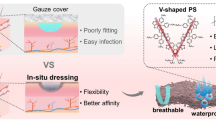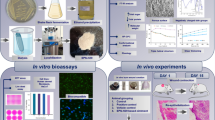Abstract
Material barrier properties to microbes are an important issue in many pharmaceutical applications like wound dressings. A wide range of biomaterials has been used to manage the chronic inflamed wounds. Eight hydrogel membranes of poly vinyl alcohol (PVA) with κ-carrageenan (KC) and Lactobacillus bulgaricus extract (LAB) have been prepared by using freeze–thawing technique. To evaluate the membranes efficiency as wound dressing agents, various tests have been done like gel fraction, swelling behavior, mechanical properties, etc. The antibacterial activities of the prepared membranes were tested against the antibiotic-resistant bacterial isolates. In addition, the safety usage of the prepared hydrogel was checked on human dermal fibroblast cells. The anti-inflammatory properties of the prepared hydrogel on LPS-PBMC cell inflammatory model were quantified using enzyme-linked immunosorbent assay (ELISA) and real-time polymerase chain reaction (RT-qPCR). The analysis data of TGA, SEM, gel fraction, and swelling behavior showed changes in properties of prepared PVA\KC\LAB hydrogel membrane than pure PVA hydrogel membrane. The antibacterial activities of the prepared membranes augmented in LAB extract-prepared membranes. Out of the eight used hydrogel membranes, the PVAKC4 hydrogel membrane is the safest one on fibroblast cellular proliferation with a maximum proliferation percentage 97.3%. Also, all the used hydrogel membrane showed abilities to reduce the concentration of IL-2 and IL-8 compared with both negative and positive control. In addition, almost all the prepared hydrogel membrane showed variable abilities to downregulate the expression of TNF-α gene with superior effect of hydrogel membrane KC1. PVA/KC/LAB extract hydrogel membrane may be a promising material for wound dressing application and could accelerate the healing process of the chronic wound because of its antimicrobial and anti-inflammatory properties.









Similar content being viewed by others
References
Xu X, Costa A, Burgess D. Protein encapsulation in unilamellar liposomes: high encapsulation efficiency and a novel technique to assess lipid–protein interaction. J Pharm Res. 2012;29:1919–31.
Morita K, Shimoyamada M. Proposal of mechanism of the freeze–thaw fractionation of 7S and 11S globulins in soy milk. Food Chem. 2013;140:39–42.
Chou KS, Liu HL, Kao LH, Yang CM, Huang SH. A novel granulation technique using a freeze–thaw method. Ceram Int. 2014;40:8875–8.
Cuicui D, Min Z, Guoying L. Effect of cyclic freeze–thawing process on the structure and properties of collagen. Int J Biol Macromol. 2015;80:317–23.
Chen G, He G. Separation of water and oil from water-in-oil emulsion by freeze/thaw method. Sep Purif Technol. 2003;31:83–9.
Benjakul S, Bauer F. Physicochemical and enzymatic changes of cod muscle proteins subjected to different freeze–thaw cycles. J Sci Food Agric. 2000;80:1143–50.
Kueltzo LA, Wang W, Randolph TW, Carpenter JF. Effects of solution conditions, processing parameters and container materials on aggregation of a monoclonal antibody during freeze–thawing. J Pharm Sci. 2008;97:1801–12.
Afshari MJ, Sheikh N, Afarideh H. PVA/CM-chitosan/honey hydrogels prepared by using the combined technique of irradiation followed by freeze-thawing. Radiat Phys Chem. 2015;113:28–35.
Peppas CM, Peppas NA. Structure and morphology or freeze/ thawed PVA hydrogels. Macromolecule. 2000;33:2472–9.
Lazaridou A, Biliaderis CG. Cryogelation of cereal β-glucans: structure and molecular size effects. Food Hydrocoll. 2004;18:933–47.
Ricciardi R, Auriemma F, Gaillet C, De Rosa C, Lauprêtre F. Investigation of the crystallinity of freeze/thaw poly (vinyl alcohol) hydrogels by different techniques. Macromolecule. 2004;37:9510–6.
Podorozhk EA, Kurskaya EA, Kulakova VK, Lozinsky VI. Cryotropic structuring of aqueous dispersions of fibrous collagen: the influence of the initial pH values. Food Hydrocoll. 2000;14:111–20.
Giusti P, Lazzer L, Barbani N, Narducci P, Bonaretti A, Palla M, et al. Hydrogels of poly (vinyl alcohol) and collagen as new bioartificial materials. J Mater Sci Mater Med. 1993;4:538–42.
Watase M, Nishinari K. Thermal and rheological properties of poly(vinyl alcohol) hydrogels prepared by repeated cycles of freezing and thawing. Makromol Chem. 1988;189:871–80.
Kim JO, Park JK, Kim JH, Jin SG, Yong CS, Li DX, et al. Development of polyvinyl alcohol-sodium alginate gel-matrix-based wound dressing system containing nitrofurazone. Int J Pharm. 2008;359:79–86.
Yang D, Yu K, Ai Y, Zhen H, et al. The mineralization of electrospun chitosan/poly(vinyl alcohol) nanofibrous membranes. Carbohydr Polym. 2011;84:990–6.
Sahoo SK, Panyam J, Prabha S, Labhasetwar V. Residual polyvinyl alcohol associated with poly(d, l-lactide-co-glycolide) nanoparticles affects their physical properties and cellular uptake. J Control Release. 2002;82:105–14.
Xiaoliang Q, Xinyu H, Wei W, Hao Y, Junjian LJianfa Z, Wei D. Investigation of Salecan/poly(vinyl alcohol) hydrogels prepared by freeze/thaw method. Carbohydr Polym. 2015;118:60–9.
Kobayashi M, Oka M. Characterization of a polyvinyl alcohol-hydrogel artificial articular cartilage prepared by injection molding. J Biomater Sci Polym Ed. 2004;15:741–51.
Ossipov D, Kootala S, Yi Z, Yang Y. Orthogonal chemoselective assembly of hyaluronic acid networks and nanogels for drug delivery. Macromolecules. 2013;46:4105–13.
Liu Y, Vrana NE, Cahill P, Mc Guinness GB. Physically crosslinked composite hydrogels of PVA with natural macromolecules: structure, mechanical properties, and endothelial cell compatibility. J Biomed Mater Res B. 2009;90:492–502.
Piculell L. Gelling carrageenans. In: Stephen AM, Phillips GO, Williams PA, editors. Food polysaccharides and their applications. 2nd edn. Boca Raton; 2006. p. 239–288.
Chibata I, Tosa T, Sato T. Application of carrageenan beads for chromatographic purification of proteins. J Chromatogr A. 1981;215:93–8.
El Fawal GF. Preparation, characterization and antibacterial activity of biodegradable films prepared from carrageenan. J Food Sci Technol. 2014;51:2234–9.
Campo VL, Kawano DF, da Silva DB, Carvalho I. Carrageenans: biological properties, chemical modifications and structural analysis—a review. Carbohydr Polym. 2009;77:167–80.
Prajapati VD, Maheriya PM, Jani GK, Solanki HK. Carrageenan: a natural seaweed polysaccharide and its application. Carbohydr Polym. 2014;105:97–112.
Ellis A, Jacquier JC. Manufacture of food grade κ-carrageenan microspheres. J Food Eng. 2009;94:316–20.
Chan SW, Mirhosseini H, Taip FS, Ling TC, Tan CP. Comparative study on the physicochemical properties of κ-carrageenan extracted from Kappaphycus alvarezii (doty) doty ex Silva in Tawau, Sabah, Malaysia and commercial κ-carrageenans. Food Hydrocoll. 2013;30:581–8.
Suguna L, Singh S, Sivakumar P, Sampath P, Chandrakasan G. Influence of Terminalia chebula on dermal wound healing in rats. Phytother Res. 2002;16:227–31.
Morin RJ, Tomaselli NL. Interactive dressings and topical agents. Clin Plast Surg. 2007;34:643–58.
Halper J, Leshin LS, Lewis SJ, Li W. Wound healing and angiogenic properties of supernatants from Lactobacillus cultures. Exp Biol Med (Maywood). 2003;228:1329–37.
Hansen JE, Jespersen LK. Wound or tissue dressing comprising lactic acid bacteria. Patent, US; 2010.
El-Deeb N, Sharaf MM, El-Adawi H. Antibacterial and plasmid curing activity against multidrug resistant bacteria strains. Int J Pharmacol. 2015;11:114–21.
Peppas NA, Stauffer SR. Reinforced uncrosslinked poly(− vinyl alcohol) gels produced by cyclic freezing–thawing processes: a short review. J Control Release. 1991;16:305–10.
EL-Adawi H, Khalil MA, EL-Sheekh MM, El-Deeb NM, Hussein MZ. Cytotoxicity assay and antioxidant activities of the lactic acid bacterial strains. Afr J Microbiol Res. 2012;6:1700–12.
Yang X, Liu Q, Chen X, Yu F, Zhu Z. Investigation of PVA/ws-chitosan hydrogels prepared by combined gama-irradiation and freeze–thawing. Carbohydr Polym. 2008;73:401–8.
Hadi H, Idayu IJ. Modification and swelling kinetic study of kappa-carrageenan-based hydrogel for controlled release study. J Chin Inst Chem Eng. 2013;44:182–91.
Borenfreund E, Puerner JA. Toxicity determined in vitro by morphological alterations and neutral red absorption. Toxicol Lett. 1985;24:119–24.
Lohr HF, Goergen B, Buschenfelde KH, Gerken GJ. HCV replication in mononuclear cells stimulates anti- HCV-secreting B cells and reflects nonresponsiveness to interferon-alpha. J Med Virol. 1995;46:314–20.
Augustine R, Dominic EA, Reju I, Kaimal B, Kalarikkal N, Thomas S. Electrospun polycaprolactone membranes incorporated with ZnO nanoparticles as skin substitutes with enhanced fibroblast proliferation and wound healing. RSC Adv. 2014;4(47):24777–85.
Augustine R, Rajendran R, Cvelbar U, Mozetič M, George A. Biopolymers for health, food, and cosmetic applications. Handb Biopolym Mater Blends Compos Gels Complex Netw. 2013; p. 801–849
Katayama T, Nakauma M, Todoriki S, Phillips GO, Tada M. Radiation-induced polymerization of gum Arabic (Acacia sengal) in aqueous solution. Food Hydrocoll. 2006;20:983–9.
Sato E, Matsuo, Tanaka. T Kinetics of discontinuous volume-phase transition of gels. J Chem Phys. 1988;89:1695–703.
Choi YS, Hong SR, Lee YM, Song KW, Park MH, Nam YS. Study on gelatin-containing artificial skin: I. Preparation and characteristics of novel gelatin-alginate sponge. Biomaterials. 1999;20:409–17.
Balakrishnan B, Mohanty M, Umashankar PR, Jayakrishnan A. Evaluation of an in situ forming hydrogel wound dressing based on oxidized alginate and gelatin. Biomaterials. 2005;26:6335–42.
Joshua SB, Harshavardhan VP, John T. Polyox and carrageenan based composite film dressing containing anti-microbial and anti-inflammatory drugs for effective wound healing. Int J Pharm. 2013;441:181–91.
Costa-Júnior ES, Barbosa-Stancioli EF, Mansur AA, Vasconcelos WL, Mansur HS. Preparation and characterization of chitosan/ poly(vinyl alcohol) chemically crosslinked blends for biomedical applications. Carbohydr Polym. 2009;76:472–81.
Sung JH, Hwang MR, Kim JO, Lee JH, Kim YI, Kim JH. Gel characterisation and in vivo evaluation of minocycline-loaded wound dressing with enhanced wound healing using polyvinyl alcohol and chitosan. Int J Pharm. 2010;392:232–40.
Wu J, Gong X, Fan Y, Xia H. Physically crosslinked poly (vinyl alcohol) hydrogels with magnetic field controlled modulus. Soft Matter. 2011;7:6205–12.
Autissier AL, Visage C, Pouzet C, Chaubet F, Letourneur D. Fabrication of porous polysaccharide-based scaffolds using a combined freeze-drying/cross-linking process. Acta Biomater. 2010;6:3640–8.
Allen CN, Harpur ES, Gray TJ, Hirst BH. Toxic effects of non-steroidal anti-inflammatory drugs in a human intestinal epithelial cell line (HCT-8) as assessed by the MTT and neutral red assays. Toxicol in Vitro. 1991;5:183–91.
Hwang MR, Lee JH, Kim YI, Kim JH, et al. Gentamicin-loaded wound dressing with polyvinyl alcohol/dextran hydrogel: gel characterization and in vivo healing evaluation. AAPS PharmSciTech. 2010;11:1092–103.
Trengove NJ, Bielefeldt-Ohmann H, Stacey MC. Mitogenic activity and cytokine levels in non-healing and healing chronic leg ulcers. Wound Rep Regen. 2000;8:13–25.
Author information
Authors and Affiliations
Corresponding author
Rights and permissions
About this article
Cite this article
El-Fawal, G.F., Yassin, A.M. & El-Deeb, N.M. The Novelty in Fabrication of Poly Vinyl Alcohol/κ-Carrageenan Hydrogel with Lactobacillus bulgaricus Extract as Anti-inflammatory Wound Dressing Agent. AAPS PharmSciTech 18, 1605–1616 (2017). https://doi.org/10.1208/s12249-016-0628-6
Received:
Accepted:
Published:
Issue Date:
DOI: https://doi.org/10.1208/s12249-016-0628-6




